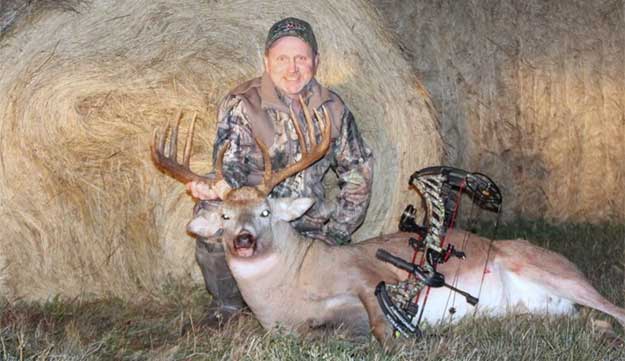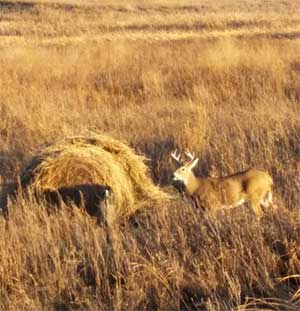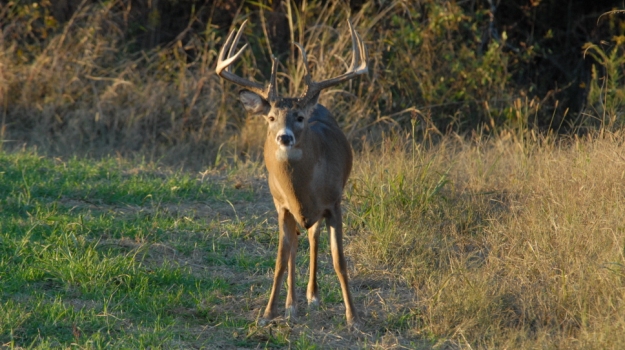by DJ Randolph | Regional ProStaff Manager

I moved to North Dakota 24 years ago from southeast Ohio. I had grown up hunting hills and hardwoods. The open farm and ranch land of North Dakota presented a whole new challenge. I knew there were big deer here, but I wasn’t sure how to go about hunting them. I had to learn to think like a prairie whitetail.
The open farmland of North Dakota presents a whole different hunting environment for most eastern hunters. The huge fields of corn, sunflowers and soybeans make an endless food source and produce some great bucks. The lack of trees and natural funnels makes deciphering how to hunt these deer a learning experience.
Sloughs & Conservation Reserve Program
As a hardwoods hunter, I had no idea how deer used sloughs and CRP. In this open country, cattails and tall CRP provide some of the best bedding areas for deer. These areas provide shelter from the wind and easy access to food and water. They are also usually a maze of trails that allow many exit routes when needed. When not pressured, deer feel very safe here.
 These areas can be extremely tough to hunt because there are often no trees for stands. Hunting from ground blinds is a challenge because from the ground it’s hard to see very far in the 5-foot-tall grass and cattails. The best option is to find a place where the trails in and out of the CRP lead into more huntable terrain. Ground blinds near field edges work well but usually have to be setup far ahead of time to allow the deer to get used to them. It’s also very important to stake blinds down well in this open country. The straight line winds we get out here will wreck a ground blind very quickly.
These areas can be extremely tough to hunt because there are often no trees for stands. Hunting from ground blinds is a challenge because from the ground it’s hard to see very far in the 5-foot-tall grass and cattails. The best option is to find a place where the trails in and out of the CRP lead into more huntable terrain. Ground blinds near field edges work well but usually have to be setup far ahead of time to allow the deer to get used to them. It’s also very important to stake blinds down well in this open country. The straight line winds we get out here will wreck a ground blind very quickly.
When hunting this close to bedding areas every precaution to minimize scent must be taken. I always where rubber boots when I am in the area and I spray everything I touch with a scent killer type spray. It’s also very important to plan entrance and exit routes. When hunting close to bedding it’s critical to avoid spooking deer when coming to or exiting your blind or stand. When the hunt is over, I try to exit the area in the shortest route and as quickly as possible. Mature deer will find a new bedding area as soon as they feel this one has been compromised.
One of my favorite places to hunt is a mix of 200 acres of cattails and tall CRP grass. It also borders up against similar acreage so this creates a huge tract of prime whitetail habitat. Years ago we built a box blind that sits 6 feet off the ground and staked it out at the edge of the CRP. This provides a place to catch deer going to and coming from their bedding area. It is also near a prairie trail that provides an excellent entrance and exit route. This area has provided many memorable hunts, but fall of 2015 is my favorite.
It was October 25, the moon was full, temps had fallen into the low 40s and fog was starting to develop. I had 7 does and fawns in front of me and it was approaching last light. All of a sudden all the deer started staring west. Then I heard movement in the chest high sweet clover. Next, all I saw were antlers coming through the CRP. All the does spread out and a very nice buck steps into the clearing, no doubt a shooter. He was at 25 yards so I settled my 20-yard pin and “thwack.” I watched him disappear into the tall grass and fog with a Nocturnal nock glowing as he went. After a tough tracking job, I found him about 125 yards away. Turns out it was the big 5x6 that I had on camera many times. I couldn’t have been happier.




























